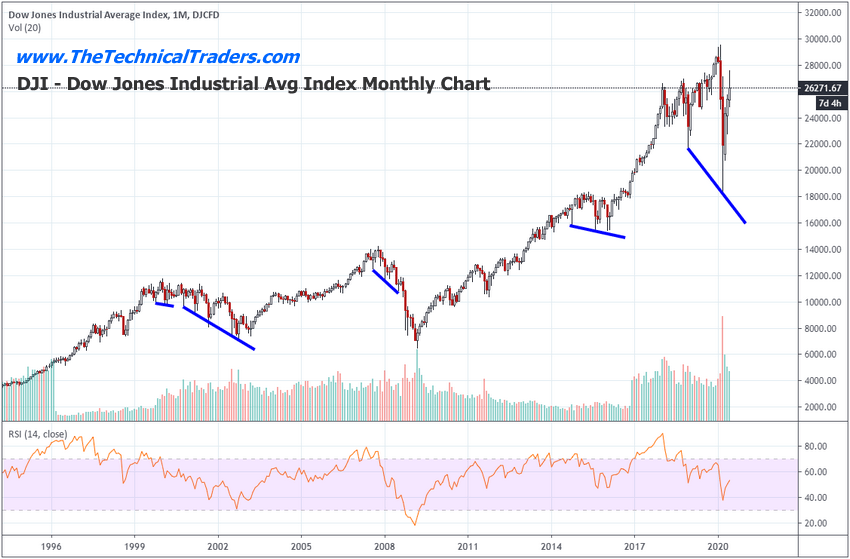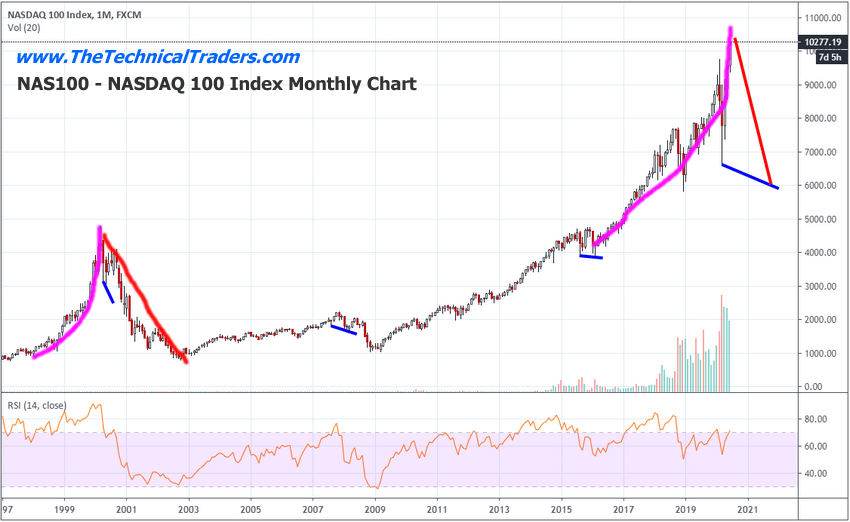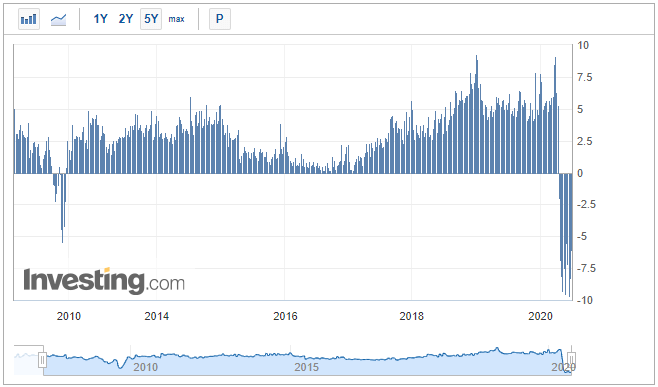US Stock Market Enters Parabolic Price Move – Be Prepared, Part II
In the first part of this research article, we briefly discussed the recent price and global economic events related to the 2018 to 2020 US stock market volatility and the COVID-19 virus event. The premise of this research post was to highlight the current upside parabolic price trend that initiated shortly after the 2015~16 US election cycle event. It is almost impossible to look at the NAS100 chart, below, and not see the dramatic upside price advance that took place after the November 2016 US elections.
It is almost as if the US stock markets had been primed by
Federal Reserve intervention over the previous 5+ years and someone let the
monster out of the cage. The
deregulation, changes to tax structures and general perception of market
opportunity changed almost immediately after the November 2016 elections and
really never looked back.
BUBBLE PSYCHOLOGY
& PROCESS
A close friend of mine suggested the current tax structures provide a very clear advantage for corporations which allows them to retain a minimum of 14% more revenue annually. This is a huge advantage for any profitable US corporation when one considers all aspects of tax laws. Additionally, President Trump changed the system from a “global” to a “territorial” structure. (Source:https://en.wikipedia.org) This provided additional tax reductions for multi-national corporations and prompted US companies to stay within the US. These new tax laws had a major impact on the bottom line after-tax revenues for thousands of US companies over the past 3+ years.
Yet, one has to earn a profit to be able to take advantage of these tax law changes and the COVID-19 virus event has put a serious dent in the earning capabilities of thousands of the US and foreign companies. The Redbook YoY data, representing Retail and Consumer Merchandise activity, has continued to post negative levels that appear to be far greater than at any time over the past 20+ years.
How can one rationalize the upward parabolic price trend continuing while the consumer sector, the largest segment of US GDP, has collapsed to levels that are more than double those of the 2008-09 credit crisis? The only answer in our minds is that a euphoric “bubble” has set up in the minds of speculative and foreign traders. This “bubble psychology” takes place when certain factors have been put into place. Typically, these factors include
_Displacement: when new technology, process, innovation or
product/production capabilities disrupt and displace existing
technologies. This creates an
opportunity for traders and investors to “shift focus” and creates a new,
untested, valuation process for the company or asset.
_Credit Creation: when central banks act in a manner to support the credit market, capital investment, and corporate enterprise. This creates the opportunity for new enterprises, businesses, and corporations to “startup” and creates a facility for capital investment from speculators, traders, VCs, and investors.
_Euphoria: the feeling that nothing can go wrong. You can invest in almost anything and make money. You could stand on the corner and sell empty cardboard boxes for $400 all day long because something thought they could “flip them” for $800 to the next person that walked by. This euphoria phase is a “self-feeding frenzy” that improperly validates very destructive behavior. In this phase, everyone feels utterly fantastic – until…

Now, you have to start asking yourself a few questions at this point in time.. Have we seen any of these phases over the past 10+ years? If so, how far along are we into these phases? Bitcoin was a displacement component that didn’t really start to take off until 2011~2013.
After that initial rally, it launched into a euphoric phase with the historic rally to $13,880. WeWork was another displacement component – promising a high-level remote work environment for the Gig/Millennial workers of the world. It built a foundation, found Softbank to back it, rallied to extreme valuations – then what? Hundreds of other displacement companies exist that have yet to deliver any proven profits. Their valuations are incredible and their believers continue to pour more and more capital into them with the expectation that “nothing can go wrong”. All of this reminds me of the Beanie-Baby craze years ago.
What next?
Financial Distress: when traders and investors begin to pull away from the euphoria and begin to revalue their belief in the ability of the displacement company to really engage in huge revenue creation. When more and more traders and investors begin to move in this direction, suddenly we see a change in how people really value assets and future expectations. The displacement company that everyone loved 5 months ago becomes the distressed company that everyone questions.
Before you continue, be sure to opt-in to our free market trend signals
before closing this page, so you don’t miss our next special report!
And this leads to…
_Revulsion: when trust in the markets and valuation levels is completely lost to almost everyone. This is what I like to call the “shock-wave” of the bubble. And this revaluation process leads everyone to run for the exits before the last bobblehead on TV suggests “this is only temporary, buy everything and you’ll be really happy in 20+ years – don’t worry”.
(Source: https://medium.com/datadriveninvestor/the-psychology-of-financial-bubbles-924f7323b591
)
THE SETUP
Our research team believes we are very near to the “financial
distress” phase of bubble psychology as a result of the COVID-19 virus event
and the disruptions to the financial markets in 2018 and 2019. A number of critical “blips” took place over
this time that very few people really paid attention to.
_ The revised corporate tax laws created a revenue source for
all existing corporations that prompted a massive push for capital to be
deployed in the US stock market. That
14%+ extra revenue suggested that everyone would see increased bottom line
profits if they could make a profit.
_ The Case-Schiller US National Home Price Index has risen almost 70 points since 2013 (just over 7 years ago). The only other time in history the Case-Schiller US National Home Price Index has risen that fast was between 2001 and 2007. Consider that for a moment.
_ The US Fed burped up an error in August 2018. This error prompted a change in future
guidance from the US Fed from a hawkish Fed to a very dovish Fed. Basically, the markets collapsed on Fed
comments and the Fed became more accommodating – almost immediately.
_ Speculative investments (both foreign and domestic) pushed to higher and higher levels. Homes flipped. Cars flipped. Everything flipped and traders/investors pour billions into the US technology markets and other sectors because “nothing could go wrong”. Even as we knew the world was upended by geopolitical trade issues, foreign credit collapse events, BREXIT and dozens of other issues near the end of 2019, the US stock market rallied to new highs well into February 2020 – even though we knew the Corona Virus was making its way around the world and could be a complete disaster.
Then, the first phase of the financial distress hit – February 24, 2020. That big bad day when the markets suddenly realized “uh oh – this could be bad” and traders/investors throughout the world watched as almost the entire globe “shut down” because of the COVID-19 virus. What does that to the earning capabilities of almost all of the global corporations and businesses? How are they going to be able to sustain revenues to take advantage of those tax breaks when their businesses have collapsed by 40%, 60%, 80%, or more? Is everything going to go back to the euphoric party mode or not?
Right now, the Fed has again come to the rescue with more
credit and the markets ate it up like cotton-candy covered in gum-drops. Everyone wanted to get back to that euphoric
feeling so badly, they jumped into the markets almost as soon as they heard
that the US Fed would “intervene” – off we go into parabolic trending.
If you are starting to understand what we are attempting to illustrate for you, then you already know how this article ends. The parabolic price trends we’re seeing right now are likely the end stage of a hyper-inflated, credit-fueled price trend. Yes, they could continue to rally much higher from current levels. Or, it could all suddenly come to a stop as Q2 comes to a close and everyone starts to suddenly realize “uh oh – that’s not good”.
We’ve been warning our client and followers for almost 10+
months that our super-cycle research suggested the end of 2019 and all of 2020
and 2021 were going to be incredibly volatile periods in the markets. We warned that traders needed to start
investing in Gold and Silver back in 2017 and 2018 – to hedge against
risks. We issued a Black Swan warning on
February 21, 2020 – just days before the markets collapsed as a result of the
COVID-19 virus. Now, we’re warning that
this current parabolic upside price trend near the end of Q2:2020 could be a
massive setup for one of the biggest “revaluation” events we’ve seen since
1999~2000 (the last big bubble).

Our researchers believe a shift away from the global financial speculation that has driven a total global asset bubble over the past 8+ years will suddenly shift away from wild speculative euphoria and quickly transition into the realization phase of “uh oh, what have we done”. It is this point that we suddenly enter a financial distress phase where investors flee over-inflated assets to move into risk hedging strategies. Why do you think Gold has rallied to levels near $1800 over the past 4+ years? A certain segment of global investors has already had their “uh oh” moment.
The US stock market has gone parabolic because a very unique set of circumstances have come together at this particular time in history. Now, we have to deal with the current and future phases of this cycle and prepare for what’s next. Protect your open long trades and/or take some profits out now. If our research is correct, we have already entered the Financial Distress phase. Q2: 2020 may be the catalyst event and that is only a few days away.
Get our Active ETF Swing Trade Signals or if you have any type of retirement account and are looking for signals when to own equities, bonds, or cash, be sure to become a member of my Passive Long-Term ETF Investing Signals which we are about to issue a new signal for subscribers.
Chris Vermeulen
Chief Market Strategies
Founder of Technical Traders Ltd.






